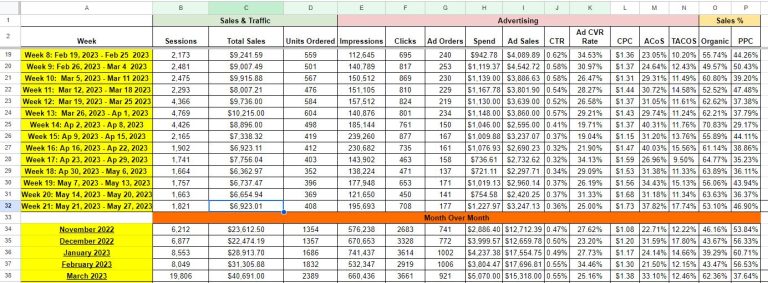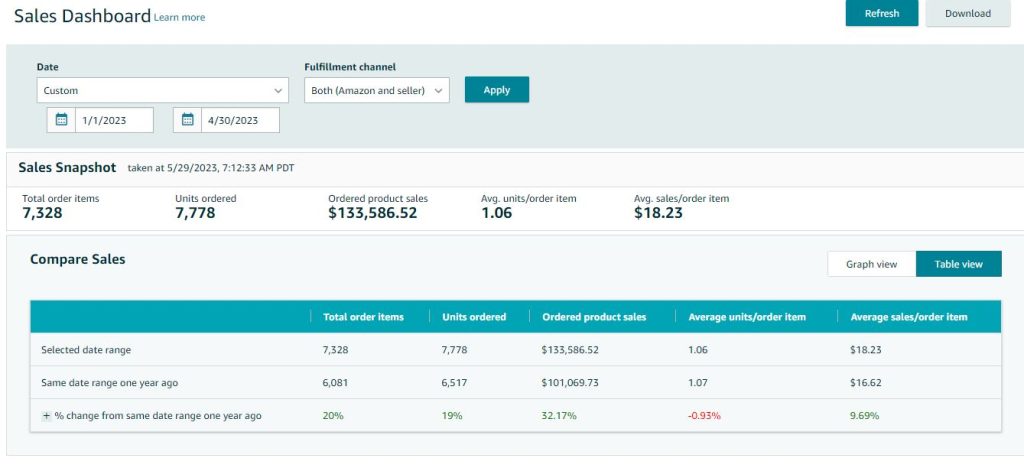Case Study 3
Optimizing Amazon PPC Campaigns to Double Sales and Reduce TACoS for Brand Ocean Balance

Brand Ocean Balance was assigned to our team in November with the initial sales figure of $23,600. Our primary goal was to optimize the Amazon PPC (Pay-Per-Click) campaigns for this brand, focusing on reducing wasteful spending, conducting comprehensive keyword research, and restructuring the campaigns to improve rankings and increase sales. This case study outlines the strategies and actions implemented to achieve these objectives, ultimately leading to a significant boost in sales and a reduced Total Advertising Cost of Sale (TACoS).
2. Challenges and Objectives:
Upon taking over the brand, we identified the following challenges and established the following objectives:
– High wasteful spending in PPC campaigns.
– Inefficient keyword targeting and campaign structuring.
– Low sales performance.
– High TACoS.
– Double the sales within a reasonable timeframe.
– Keep TACoS to 15% or below.
3. Methodology:
To address the challenges and achieve the objectives, the following steps were taken:
3.1. Wasteful Spend Analysis:
We conducted an in-depth analysis of the existing PPC campaigns to identify areas of wasteful spending. Based on the data collected, we eliminated keywords with poor performance and optimized bids and budgets to allocate resources more efficiently.
3.2. Keyword Research and Campaign Restructuring:
We performed extensive keyword research to identify high-value and relevant keywords for the brand. Using this data, we restructured the campaigns, creating new ad groups and tightly themed campaigns to improve keyword targeting, relevancy, and Quality Scores.
3.3. Bid Optimization:
We implemented a bid optimization strategy to maximize the visibility of high-performing keywords while controlling costs. By monitoring keyword performance, adjusting bids, and leveraging Amazon’s bidding strategies, we aimed to achieve a balance between sales growth and cost efficiency.
3.4. Ad Copy and Creative Optimization:
We continuously reviewed and optimized ad copy and creatives to improve click-through rates (CTRs) and conversion rates. A/B testing was conducted to identify the most effective messaging and creative elements for the target audience.

3.5. Continuous Monitoring and Performance Analysis:
We closely monitored the performance of the PPC campaigns, tracking key metrics such as sales, TACoS, click-through rates, conversion rates, and keyword rankings. Regular performance analysis allowed us to identify trends, make data-driven decisions, and implement necessary adjustments to optimize campaign performance further.
4. Results:
Following the implementation of the optimization strategies, the following results were achieved:
4.1. Sales Growth:
By refining the campaign structure, targeting high-value keywords, and optimizing bids, we were able to almost double the sales. The current sales figure stands at $40,600, representing a significant increase from the initial $23,600.
4.2. TACoS Reduction:
Through improved campaign management and cost control, we successfully kept the TACoS upto 12%, meeting the predetermined objective. This reduction indicates a more efficient allocation of advertising spend, leading to better profitability.
5. Conclusion:
By implementing a comprehensive optimization strategy for the Amazon PPC campaigns of Brand XYZ, we were able to achieve remarkable results. Our efforts resulted in a nearly doubled sales figure while keeping the TACoS at or below 12%. The successful outcomes were a direct result of eliminating wasteful spend, conducting thorough keyword research, restructuring campaigns, and continuously monitoring and optimizing campaign performance. These improvements demonstrate the effectiveness of data-driven strategies and the importance of ongoing optimization to maximize sales and profitability on the Amazon platform.
